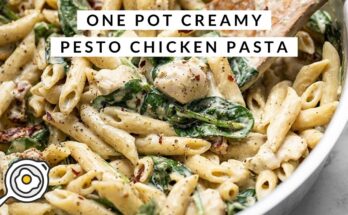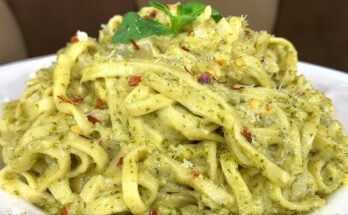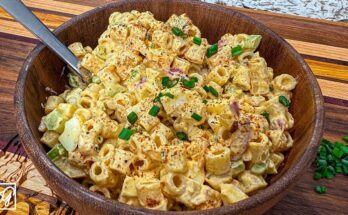Chicken Paprika Recipe: Chicken Paprika, also known as “Csirkepaprikás” in Hungarian, hails from the heart of Central Europe—Hungary. It dates back centuries, with its roots deeply tied to the rich traditions of Hungarian home cooking. The dish became a staple across Eastern Europe, thanks to its straightforward ingredients and bold flavors. Paprika, introduced to Hungary in the 16th century, soon became the nation’s beloved spice. By the 19th century, paprika wasn’t just a seasoning; it was a cultural identity. Chicken Paprika, combining this iconic spice with affordable ingredients, became the soul food of Hungarian families. Over time, it spread beyond borders and found its way into global kitchens.
This dish isn’t just food; it’s history served on a plate. It’s the kind of meal that has been passed down from grandmothers to grandchildren, each family adding its own twist. The red hue of paprika, the tenderness of the chicken, and the creamy sauce reflect the warmth and passion of Hungarian cooking.
What Makes Chicken Paprika Special?
So, what really makes Chicken Paprika stand out from other chicken dishes? It’s the paprika, hands down. Not just any paprika, though—Hungarian paprika. This unique spice comes in a variety of flavors, from sweet to hot, offering layers of complexity. Another standout feature is its luscious, velvety sauce made from a simple base of onions, garlic, and sour cream.
Then there’s the texture. When cooked right, the chicken becomes incredibly tender, absorbing all the smoky, sweet flavor from the paprika. Add in a creamy base and you’ve got a dish that’s both rustic and luxurious.
It’s also incredibly versatile. Whether served with egg noodles, dumplings, rice, or even mashed potatoes, Chicken Paprika easily adapts to what you have in your pantry. Plus, it’s naturally gluten-free (just be mindful of the thickeners or flour, if used), making it a great option for many diets.
Ingredients You’ll Need
Essential Ingredients
Here’s what you absolutely need to make an authentic Chicken Paprika dish:
- Chicken pieces (bone-in thighs or drumsticks are ideal): 2 pounds
- Hungarian sweet paprika: 3 tablespoons
- Onions (finely chopped): 2 medium
- Garlic cloves (minced): 3-4
- Chicken broth: 2 cups
- Sour cream: 1 cup
- All-purpose flour: 1 tablespoon (optional, for thickening)
- Salt and pepper: to taste
- Oil or butter: 2 tablespoons (for sautéing)
These basic ingredients come together to create magic. The key here is using high-quality paprika. Cheap paprika often lacks the depth and flavor required to make this dish sing. If possible, opt for imported Hungarian paprika—it makes a world of difference.
Optional Add-ons to Elevate Flavor
Want to get a little fancy or customize the dish to your liking? Here are some optional additions:
- Smoked paprika: Add 1 tsp for a deeper, smokier profile.
- Tomato paste: 1 tablespoon for extra richness.
- Bell peppers: sliced and added with onions for sweetness.
- Caraway seeds: a traditional Hungarian spice for an earthy touch.
- Bay leaf: for an aromatic boost during simmering.
While these extras aren’t mandatory, they can add layers of complexity that make your version of Chicken Paprika uniquely yours. Experiment with different combinations until you find your perfect flavor.
Kitchen Tools Required
Basic Cooking Equipment
You don’t need any fancy gadgets to whip up this comforting classic. Here’s what you’ll need:
- Large skillet or Dutch oven: Preferably with a lid, for even cooking.
- Knife and chopping board: For prepping onions, garlic, and chicken.
- Measuring spoons and cups: To get the ratios right.
- Mixing bowl: For combining sour cream and flour, if used.
Make sure your skillet or pot is wide enough to hold all the chicken pieces in a single layer. This ensures even cooking and better flavor absorption.
Recommended Utensils for Best Results
While not essential, the following tools can make your cooking experience smoother:
- Wooden spoon: Gentler on your pan and perfect for stirring the sauce.
- Whisk: To blend the sour cream and flour without lumps.
- Tongs: Handy for flipping chicken pieces while searing.
- Ladle: For serving the final dish gracefully.
When you’re working with a dish as old-school as Chicken Paprika, keeping your tools simple honors the tradition. It’s all about letting the ingredients shine without overcomplicating things.
Step-by-Step Chicken Paprika Recipe
Step 1: Prepping the Chicken
Start by patting your chicken pieces dry with a paper towel. This helps achieve a nice sear. Season both sides with salt and pepper. If your chicken has skin, you can leave it on for more flavor, or remove it for a leaner dish.
Heat oil or butter in your skillet over medium-high heat. Once hot, add the chicken pieces skin-side down and sear until golden brown (about 4-5 minutes per side). This process locks in the juices and adds depth to the sauce.
Remove the browned chicken and set aside. Don’t worry if it’s not cooked through yet—it will finish cooking later. What’s left in the pan—those brown bits—is flavor gold. Keep that!
Step 2: Creating the Flavor Base
Now that your chicken is beautifully browned and set aside, it’s time to build that iconic flavor base. Start by lowering the heat to medium and adding a bit more oil or butter if the pan looks dry. Toss in your chopped onions and sauté until they become soft, golden, and aromatic—this should take about 8–10 minutes.
Next, stir in the minced garlic and cook for another minute, being careful not to let it burn. Then comes the star of the show: paprika. Sprinkle the paprika over the onions and garlic, and immediately stir to combine. Be cautious here—paprika can burn quickly and turn bitter, so mix it swiftly into the onions.
At this point, you can add a spoonful of tomato paste or a few slices of bell pepper for an extra layer of flavor. These additions aren’t traditional but are often used in modern takes to deepen the taste and color.
Deglaze the pan with a splash of chicken broth, scraping up all those brown bits stuck to the bottom. That’s pure umami. Once it simmers, return your browned chicken to the pan, nestling it into the sauce.
Step 3: Simmering and Cooking
Pour the remaining chicken broth over the chicken until it’s mostly covered, then bring the mixture to a gentle boil. Reduce the heat to low, cover with a lid, and let it simmer for about 30–35 minutes. The goal here is slow cooking to tenderize the meat and allow all the flavors to meld.
While the chicken simmers, you’ll notice the sauce gradually thickens and deepens in color. Stir occasionally to prevent sticking and to ensure the chicken is evenly coated in the flavorful sauce.
If you want to thicken the sauce more, mix a tablespoon of flour with a few tablespoons of sour cream in a separate bowl until smooth. Once the chicken is fully cooked (internal temp of 165°F), remove it from the pan and slowly whisk in the sour cream mixture. Stir constantly to avoid curdling.
Once incorporated, return the chicken to the pan and simmer for another 5–10 minutes uncovered, letting the sauce reach a silky consistency.
Step 4: Finishing Touches
By now, your kitchen smells like a Hungarian bistro, and your chicken is fork-tender. Before serving, give the sauce a final taste. Need more salt? A touch more paprika? Adjust as needed.
To enhance the richness, some cooks add a final dollop of sour cream or a splash of heavy cream. For a more rustic vibe, garnish with chopped fresh parsley or chives.
If you want to go bold, you can also sprinkle a bit of hot paprika or chili flakes on top for a subtle kick. Presentation matters, so make sure to ladle that creamy, vibrant sauce generously over the chicken when plating.
Serve hot, ideally right after finishing the dish, to enjoy it at its flavorful best.
Tips and Tricks for Perfect Chicken Paprika
Avoiding Common Mistakes
Even though Chicken Paprika is a fairly simple dish, there are a few common pitfalls that can turn it from fabulous to forgettable. First off, don’t skimp on the paprika. It’s not just a garnish here—it’s the main flavor. Using stale, flavorless paprika is one of the biggest mistakes. Invest in a good Hungarian brand like Szeged or Pride of Szeged for the best results.
Secondly, never add paprika directly to a blazing hot pan without any liquid or fat. It burns fast and becomes bitter, ruining your sauce. Always mix it with some moisture like broth or onions to protect its delicate oils.
Using boneless, skinless chicken breasts is another common misstep. While convenient, they lack the richness and flavor of thighs or drumsticks, which hold up better during long simmering. And finally, avoid overheating your sour cream when adding it to the pan—it can curdle easily. Mix it with a bit of hot broth first to temper it.
Adjusting Spice Levels
One of the great things about this dish is how adaptable it is. Not a fan of spice? Stick to sweet Hungarian paprika. Want a bit of a kick? Blend in some hot paprika or even cayenne pepper.
Here’s a simple guide:
- Mild: Use sweet paprika only.
- Medium: Mix 2 tbsp sweet paprika with 1 tsp smoked or hot paprika.
- Spicy: Go bold with 1 tbsp hot paprika and 2 tbsp sweet.
If you’re cooking for kids or spice-sensitive guests, start mild—you can always add heat at the end. And if you like complexity, smoked paprika adds a wonderful earthy dimension that plays beautifully with the creaminess of the sauce.
You can even experiment with different types of paprika over time. Hungarian, Spanish, smoked, hot—each brings something different to the table. The more you play around, the more you’ll find what works for your taste buds.
Serving Suggestions
What to Serve with Chicken Paprika
Chicken Paprika is rich, creamy, and full of bold flavors, which means it pairs best with sides that can soak up that delicious sauce without overwhelming the dish. Here are some of the top traditional and modern accompaniments:
- Nokedli or Spaetzle: These are small, soft egg noodles, similar to dumplings. They’re the most authentic Hungarian pairing for Chicken Paprika.
- Mashed Potatoes: Creamy, buttery mashed potatoes are a great way to balance the boldness of the sauce.
- Rice: Steamed white rice or a buttery rice pilaf makes a light, neutral base for this hearty dish.
- Crusty Bread: Don’t underestimate a warm slice of rustic bread to mop up every drop of that velvety sauce.
- Egg Noodles: Wide egg noodles are another simple and satisfying choice that blends seamlessly with the paprika sauce.
If you’re looking for something lighter, you can pair it with a simple side salad—think cucumbers, tomatoes, red onions, and a vinegar-based dressing—to cut through the richness of the chicken.
The beauty of Chicken Paprika lies in its adaptability. Whether you want something carb-heavy or a veggie-forward side, this dish plays nice with almost everything.
Presentation Tips
We eat with our eyes first, right? Chicken Paprika, when plated correctly, looks just as amazing as it tastes. Here are a few simple tips to make your dish restaurant-worthy:
- Use a shallow, wide bowl or plate so the chicken sits beautifully in a pool of sauce.
- Drizzle a bit of extra sour cream or cream on top in a swirl—it adds visual flair and enhances creaminess.
- Sprinkle fresh chopped parsley or chives over the dish right before serving for a burst of color and freshness.
- Serve with a lemon wedge on the side for guests who like a hint of acidity to cut the richness.
Remember, a beautiful plate isn’t just about looks—it adds to the experience and makes the meal feel even more special.
Nutritional Information
Calorie Count and Macronutrients
Here’s a general breakdown for a single serving of Chicken Paprika (1 piece of chicken with sauce, without sides):
- Calories: 350–450 kcal
- Protein: 25–30g
- Carbohydrates: 10–15g
- Fat: 20–30g
These numbers vary depending on the cut of chicken you use (thighs vs. breasts), how much sour cream or oil is included, and whether you add flour for thickening.
For a lighter version, consider these tweaks:
- Use skinless chicken breasts.
- Opt for low-fat sour cream or Greek yogurt.
- Skip the flour or use cornstarch for thickening.
Health Benefits
While Chicken Paprika is definitely a comfort food, it still comes with some nutritional perks:
- Rich in Protein: Chicken is an excellent source of lean protein which helps in muscle repair and growth.
- Paprika Power: Paprika isn’t just for color—it’s loaded with antioxidants like vitamin A and E, which promote eye and skin health.
- Gut-Friendly Garlic and Onions: These ingredients contain prebiotics that support healthy digestion.
- Customizable Fat Levels: You can adjust the richness of the dish based on your dietary needs by choosing low-fat ingredients or reducing oil use.
With the right tweaks, you can enjoy Chicken Paprika even on a calorie-conscious diet without compromising on flavor.
FAQs about Chicken Paprika Recipe
Can I make Chicken Paprika ahead of time?
Yes! In fact, the flavors often deepen and improve when left overnight. Just store it in an airtight container in the fridge and reheat gently on the stove before serving.
What type of paprika should I use?
Hungarian sweet paprika is the gold standard. You can also experiment with smoked or hot paprika for a more complex flavor, but sweet paprika should always be the base.
Can I substitute chicken with another meat?
Absolutely. Turkey thighs or pork shoulder work well with this recipe. You can also try it with tofu or mushrooms for a vegetarian version.
How do I store leftovers?
Store leftovers in an airtight container in the fridge for up to 3 days. You can also freeze it for up to 2 months. Thaw overnight in the fridge and reheat gently.
Is Chicken Paprika gluten-free?
It can be! Just skip the flour or use a gluten-free thickener like cornstarch or arrowroot. Also, check that your paprika and broth are certified gluten-free.
Conclusion
There’s a reason why Chicken Paprika has stood the test of time—it’s comforting, flavorful, and satisfying in every way. With just a few pantry staples and a bit of love, you can create a dish that feels like a warm hug in food form. Whether you’re new to cooking or a seasoned home chef, this recipe is easy enough to master and impressive enough to serve at dinner parties.
The key lies in choosing high-quality ingredients, especially paprika, and taking your time to build flavors from scratch. Once you’ve tried this version, you’ll likely find yourself making it again and again—each time adding your own personal twist.
So next time you’re wondering what to cook for a cozy dinner, let Chicken Paprika be your go-to. Serve it with your favorite side, garnish it with love, and enjoy a piece of culinary history that’s as delicious today as it was centuries ago.



